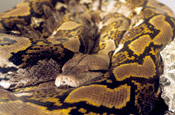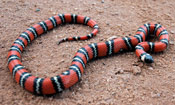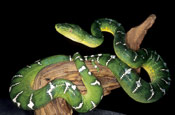Non-Venomous Snakes
There are no universal distinguishing features that separate venomous from non-venomous snakes. People must learn to identify the dangerous species of snakes in their areas or the areas they plan on visiting.
Non-venomous snakes have teeth, just like the venomous variety. So even in the case of a bite from a non-venomous snake you should still take special care and watch for infections, as with any small injury. Bites from large non-venomous snakes can also be devastating - some large python and boas are able to cause massive lacerations that require urgent medical care.
Our advice: It’s best to leave all snakes alone, just like any wildlife. They have their place in nature and would certainly prefer to leave us alone as well.
How They Hunt
Many non-venomous snakes constrict their prey. Constriction is not a bone breaking experience like we often see in the movies. A snake will strike out to bite its prey, throw a couple of coils around it and begin to squeeze. Two things generally happen: every time the animal (prey) exhales, the snake will squeeze tighter. Eventually, the animal will not be able to inhale.
However, there is so much power behind the coils that most animals typically die from heart failure because so much pressure is being applied to the chest cavity that the heart doesn’t have any room to continue beating. Death is very rapid, and in most cases takes less than a minute.
Defenses
All snakes possess teeth that can be used in defensive bites. However, most snakes rely on camouflage to avoid being seen altogether. Still, others coil up in a tight ball with the head in the middle, some rattle the tail, and a few rub their scales together to produce a rasping “leave me alone” sound, but almost all will flee if given even the slightest opportunity.
Types of Non-Venomous Snakes



Most of the world’s snakes are what are referred to as clinically non-venomous. This means they do not produce a toxin that is clinically significant to people. However, many harmless-to-humans snakes, like Hognose snakes, Garter snakes, and Rat snakes for example, do produce toxins that have toxic effects on their prey.
Boas, pythons, bullsnakes, and kingsnakes are examples of truly non-venomous snake species.
Visit our Sky Dome and maybe you’ll see one of our friendly, free-roaming pythons taking a sun bath. Want to learn more about these fascinating creatures? Be sure to catch one of our Snake Shows and see our snake handling experts and our snake ambassadors put on a show that’s sure to captivate and educate audiences of all ages.





